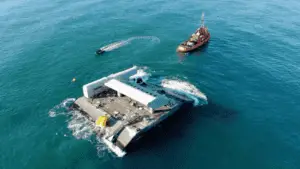5 Disadvantages of Wave Energy Explained
Disadvantages of wave energy are; geographic limitation, initial cost, marine ecologic impact, scale challenges, and economic impoundment.
This article discusses the disadvantages of wave energy, as follows;
1). Geographic Limitation (as one of the Disadvantages of Wave Energy)
Although oceans constitute up to 70% of the total surface area of the Earth [2], there are still challenges of finding a suitable location to conduct wave energy projects.
This is because not all regions share borders with the ocean, and not all offshore locations can provide sufficient wave energy on a consistent basis to be reliable and effective.
Also, some areas with sufficient wave energy may have unsuitable depth, high salinity, excessive winds, and other conditions that pose significant risk to workers, and can damage or reduce the energy efficiency of wave energy-converters.
What these instances imply is that wave energy may not be a very versatile renewable energy option with regards to where it can be used.
In addition, the transmission of electricity generated from offshore wave energy systems can be technically and economically challenging, due to the nature of marine terrains, so that it is not always easy or possible to perform long-distance transmission of wave power to remote onshore areas.
Often, in order to makeup for the geographic shortcomings of wave energy, it is harnessed in combination with wind and/or solar using hybrid systems.
While it can be beneficial to harness wave energy as a supplementary energy resource [7], this is not always a more viable approach as it comes with its own complexities.
The fact that wave energy usage is geographically constrained, means that it may not be very effective as one of the ways to facilitate sustainable development or energy transition. It also implies that some countries may not have access to the wave energy resources of their neighbors [1], causing unsustainable economic imbalances on a regional scale.
2). Initial Cost
The cost of wave energy conversion projects falls within similar range to that of other renewable energy projects like the establishment of wind farms and solar power plants [3].
Most types of wave energy converters cost between US$ 5 and 7 million on average, at the smallest scale.
These values indicate that wave energy is expensive to harness at the initial stage of system design and installation.
The cost is further increased by operational costs, which are part of the expenditure on wave energy systems over their entire lifetime [9].
It must however be acknowledged that wave energy is not very expensive, especially when compared to other clean energy resources and technologies like nuclear. The cost is only a challenge to small-scale projects and users with limited available funds.
The cost of wave power is cheap compared to other means of electricity generation, generally falling below $1.0 per kWh especially for large-scale wave energy systems.
3). Marine Ecologic Impact (as one of the Disadvantages of Wave Energy)
Although it is a clean energy resource, one of the disadvantages of wave energy is its environmental impact.
Wave energy affects the environment by disrupting the natural distribution of water, oxygen, nutrients and bioenergy in the marine ecosystem.
Marine pollution can occur as a result of harnessing wave energy. Types of pollution caused by wave energy development include aesthetic and noise pollution from wave converters installed in or on the ocean.
Minor water pollution can also result from lubricants and other chemicals used to maintain wave energy converters.
These influences can reduce the survival rate of marine organisms, and can alter the natural trend of energy and food supply in the marine energy pyramid.
Also, interaction between marine organisms and wave energy equipment can cause biofouling, where biological processes cause the degradation of these equipment, and reduce the energy efficiency of wave conversion.
Negative impacts of the marine ecosystem from wave energy processes can affect onshore areas, since the marine ecosystem makes up a significant portion of life on Earth, and plays a major role in ecologic sustainability and efforts to tackle socioeconomic problems like recession and food insecurity.
4). Scale Challenges
One of the most crucial attributes of any energy technology is scalability; which determines how easily it can be modeled to serve a given magnitude of demand.
Wave energy technology faces many challenges with respect to its scalability.
Permits that must be given for large-scale wave power projects can be difficult to attain for many operators [1], especially when the sites for these projects occur in sensitive offshore zones.
Also, it is often difficult to design large-scale wave energy installations that combine the necessary attributes of energy conservation, efficiency and performance [5], especially because of the point-contact-based nature of wave energy capture and conversion.
The scalability challenges facing wave energy can be attributed to the fact that it is a less-developed energy resource, with many models being effective only in the laboratory [6].
These shortcomings can pose risks to safety, efficiency and economy, and indicate that wave energy requires more concerted effort in research and development to make it fully reliable.
5). Economic Impoundment (as one of the Disadvantages of Wave Energy)
Although wave energy development is meant to have economic benefits, it can have negative implications for various sea-dependent sectors of the economy.
The best sites for wave converter installation coincide with major sea transport routes and commercial marine fisheries [8].
This means that any intensive development of wave energy must come at the cost of these economic activities, unless there are technological changes to make wave energy more compatible with the natural and economic ecosystem. Such technological changes are not likely to come too soon, and may not completely eliminate these effects.
Also, the environmental impacts of wave energy (discussed earlier) imply that losses are likely to occur in terms of the viability of seas for recreation and food production; as well as in the expenses made on environmental remediation.

Conclusion
Disadvantages of wave energy are;
1. Geographic Limitation
2. Initial Cost
3. Marine Ecologic Impact
4. Scale Challenges
5. Economic Impoundment
References
1). Aderinto, T.; Li, H. (2018). "Ocean Wave Energy Converters: Status and Challenges." Energies 11(5):1250. Available at: https://doi.org/10.3390/en11051250. (Accessed 27 January 2023).
2). Bar-On, Y. M.; Phillips, R.; Milo, R. (2018). "The biomass distribution on Earth." Proc Natl Acad Sci U S A. 2018 Jun 19;115(25):6506-6511. Available at: https://doi.org/10.1073/pnas.1711842115. (Accessed 1 February 2023).
3). Bosserelle, C.; Kruger, J.; Reddy, S. K. (2015). "Cost Analysis of Wave Energy in the Pacific." Waves and Coasts in the Pacific Project Report. Available at: https://www.researchgate.net/publication/305126646_Cost_Analysis_of_Wave_Energy_in_the_Pacific. (Accessed 27 January 2023).
4). Cho, R. (2017). "Tapping into Ocean Power." Available at: https://news.climate.columbia.edu/2017/02/14/tapping-into-ocean-power/. (Accessed 27 January 2023).
5). Göteman, M.; Giassi, M.; Engström, J.; Isberg, J. (2020). "Advances and Challenges in Wave Energy Park Optimization—A Review." Front. Energy Res., 06 March 2020, Sec. Sustainable Energy Systems, Volume 8 - 2020. Available at: https://doi.org/10.3389/fenrg.2020.00026. (Accessed 27 January 2023).
6). Khan, M. Z. A.; Khan, H. A.; Aziz, M. (2022). "Harvesting Energy from Ocean: Technologies and Perspectives." Energies 2022, 15, 3456. Available at: https://doi.org/10.3390/en15093456. (Accessed 27 January 2023).
7). Kies, A.; Schyska, U.; Bremen, L. (2016). "The optimal share of wave power in a highly renewable power system on the Iberian Peninsula." Energy Reports, Volume 2, November 2016, Pages 221-228. Available at: https://www.sciencedirect.com/science/article/pii/S235248471630035X. (Accessed 1 February 2023).
8). Kim, C-K.; Toft, J. E.; Papenfus, M.; Verutes, G.; Guerry, A. D.; Ruckelshaus, M. H.; Arkema, K. K.; Guannel, G.; Wood, S. A.; Bernhardt, J. R.; Tallis, H.; Plummer, M. L.; Halpern, B. S.; Polasky, S. (2012). "Catching the Right Wave: Evaluating Wave Energy Resources and Potential Compatibility with Existing Marine and Coastal Uses." PLoS ONE 7(11): e47598. Available at: https://doi.org/10.1371/journal.pone.0047598. (Accessed 27 January 2023).
9). Ruiz-Minguela, P.; Noble, D.R.; Nava, V.; Pennock, S.; Blanco, J.M.; Jeffrey, H. (2023). "Estimating Future Costs of Emerging Wave Energy Technologies." Sustainability 2023, 15, 215. Available at: https://doi.org/10.3390/su15010215. (Accessed 27 id="10"January 2023).
10). Vidjajev, N.; Palu, R.: Terentjev, J.; Hilmola, O-P.; Alari, V. (2022). "Assessment of the Development Limitations for Wave Energy Utilization in the Baltic Sea." Sustainability 4(5):10.3390/su14052832. Available at: https://doi.org/10.3390/su14052832. (Accessed 27 January 2023).




